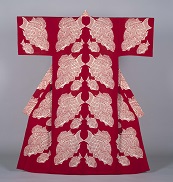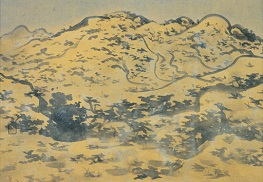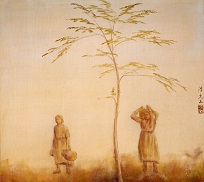Collection GalleryThe 5th Collection Gallery Exhibition 2015-2016 (163 works in all)
Collection Gallery
HOME > Collection Gallery > The 5th Collection Gallery Exhibition 2015-2016
The 5th Collection Gallery Exhibition 2015-2016 (163 works in all)
Exhibition Period
1.27 (Wed.) - 3.21 (Mon.), 2016
Overview
The National Museum of Modern Art, Kyoto has, for the past 5 years, been renovating its 30-year-old building in commemoration of the museum’s 50th anniversary held in 2013, by closing the building during the winter season. During the latest renovation work, all of the lighting for the display cases in the exhibition galleries on the 3rd and the 4th floors has been changed to LED lights to achieve uniform illumination and color temperature, which enables visitors to visually capture greater detail and material texture of the exhibits. In the next fiscal year (from April 2016 through March 2017), the acoustic system for the auditorium will be renovated without closing the museum. Visitors will therefore be able to enjoy our collections throughout the year.
Our last collection gallery exhibition of this fiscal year features an exhibit titled "Curatorial Studies 10" and other exhibits related to the "Shimura Fukumi" exhibition being held in the special exhibition gallery on the 3rd floor.
The “Curatorial Studies 10” exhibit features “The Pencil of Nature” authored by Henry F. Tablot, a British photography pioneer who invented the photographic process called calotype, and who was also a noted politician, archaeologist and etymologist.
Based on Tablot’s words and works, and utilizing our collection and loaned works from outside sources, we explore from diversified perspectives a variety of issues that were first raised by the reproduction techniques newly developed in the mid-19th century and which have continued until today.
Shimura Fukumi, whose artistic oeuvre is being featured in a special exhibition on the 3rd floor, became involved in the world of textiles by learning textile techniques from her mother, who supported the Mingei (folk craft) Movement. As the subtitle of the exhibition "A Return to Mother's Old Fabrics" clearly indicates, her starting point as a textile artist has been and always will be very important for her. In the Craft section, entitled “Beauty in Everyday Crafts: Artists in the Mingei Movement,” the works of the representative Mingei artists who influenced Shimura’s artistic activities, such as Kuroda Tatsuaki, Kawai Kanjiro, Hamada Shoji, Tomimoto Kenkichi, Serizawa Keisuke, Munakata Shiko, are being featured.

The exhibit "Special Feature: Textile and Art – Perspective beyond Boundaries" is also being held in conjunction with the Shimura Fukumi exhibition. Inspired by the words of the 19th German architect, Gottfried Semper, who said, "All other kinds of art (….) borrow patterns and symbols from textile art," "Textile is to be considered original art (Urkunst)," we try to clarify various issues subsumed, materially or/and conceptually, by the textile, by lining up textile works side by side with other works so that both their figurative and their semantic aspects can be examined.

In the Nihonga (Japanese-style painting) section, under the title of "Winter Scenery in Japanese-style Painting," paintings which feature familiar winter scenes are being introduced. In particular, a monumental work of Komatsu Hitoshi in the form of a painting constructed with two pairs of two-panel folding screens entitled, "The River Mogami in Snow," overwhelms viewers with a depiction of a grand river meandering through snow-covered fields in a relaxing manner. Even though snow is featured in many paintings, one of the most representative works of Murakami Kagaku in his later years entitled "Calm Winter Mountain" which features a mountain on a sunny day in winter, and Irie Hako's "Winter in Southern Europe" which was painted during his stay in Europe, are also worthy of note.

- Murakami Kagaku, Calm Winter Mountain, 1934

- Irie Hako, Winter in Southern Europe, 1923-26
In the Yoga (Western-style painting) section, we introduce the works of two Kyoto-born painters, Ito Kyuzaburo and Komaki Gentaro, both of whom developed unique, avant-garde style of works during the war and proceeded it later.
The last part of the "Curatorial Studies 10" exhibit features a group of photographs by Hatakeyama Naoya of the earthquake-stricken city of "Rikuzen Takata" after the Great East Japan Earthquake. His photographs silently convey to us the significance of recording "nature" and reproducing our memories. At the entrance to the Collection Gallery, one of Picasso's works created in the year following the bombing of Guernica during World War II is on display, as well as ceramic works by Koie Ryoji, which were created in the aftermath of the Chernobyl disaster in 1986.
Together with Komatsu Hitoshi's "The River Mogami in Snow" in the Japanese-style painting section, we sincerely hope that these works will help visitors remember the Great East Japan Earthquake which occurred 5 years ago, as well as stimulate them to consider the future of Japan and that of the world.
Themes of Exhibition
- ・Curatorial Studies 10: Re-reading Henry F. Talbot's The Pencil of Nature: The Etymology of Photography
- ・Winter Scenery in Japanese-style Painting
- ・Special Feature: Textile and Art ― Perspective beyond Boundaries
- ・Beauty in Everyday Crafts: Artists in the Mingei Movement
- ・Avant-garde painters in Kyoto: KOMAKI Gentaro and ITO Kyuzaburo
- ・[Outside] Outdoor Sculptures
List of Exhibits
The 5th Collection Gallery Exhibition 2015-2016
Top of this page

